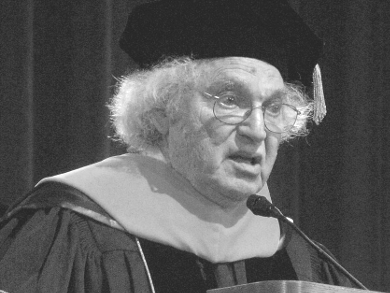Herbert Aaron Hauptman was born in New York, USA, on February 14, 1917. He grew up in the Bronx, developed an early interest in science, and with the help of financial aid, studied mathematics at the City College of New York. He continued his studies at Columbia University, NY, USA, where he received his Master’s degree in 1939. During World War II, he worked as a radar instructor for the U.S. Air Force.
After the war, Hauptman was a graduate student at the University of Maryland, College Park, USA, and received his Ph.D. there in 1955. He also joined the Naval Research Laboratory in Washington, D.C., USA. There, he worked together with Jerome Karle, a physical chemist.
The two scientists developed equations that allowed the direct determination of molecular structures from X-ray diffraction patterns. These patterns show only the amplitude of the radiation and not its phase, however, both are needed to find the structure. Using some simple assumptions, e.g., that molecules consist of discrete atoms, Hauptman and Karle’s approach allows the determination of the phases of the diffracted X-rays using only their amplitudes.
The method was criticized and rarely used in the beginning. However, the rise of computers in science between the 1960s and the 1980s allowed the easy implementation of the Hauptman-Karle method and led to an enormous acceleration in solving crystal structures. Before their breakthrough, solving the structure of even simple molecules could take years, afterward, it only took days.
In 1970, Hauptman joined the crystallographic group of the Medical Foundation of Buffalo, NY, USA. He became Research Director there in 1972. In 1985, Hauptman received the Nobel Prize in Chemistry together with Karle “for their outstanding achievements in the development of direct methods for the determination of crystal structures”.
In 1994, the Medical Foundation of Buffalo was renamed Hauptman-Woodward Medical Research Institute to honor Herbert Hauptman and philanthropist Helen Woodward Rivas. In addition to these honors, Hauptman received a large number of honorary doctorates and other awards, such as the Belden Prize in Mathematics from the City College of New York in 1935 and the Patterson Award by the American Crystallographic Association in 1984. Herbert A. Hauptman died on October 23, 2011.
Herbert A. Hauptman is the answer to Guess the Chemist (62).
Sources
- About Nobel Laureate Herbert Hauptman,
Hauptman-Woodward Medical Research Institute, Buffalo, New York, USA.
http://hwi.buffalo.edu/about-herbert-hauptman/ (accessed February 3, 2017) - Herbert Hauptman (1917–2011),
Carmelo Giacovazzo,
Nature 2011, 479, 300.
DOI: 10.1038/479300a - Herbert A. Hauptman, Nobel Laureate, Dies at 94,
William Grimes,
The New York Times, October 24, 2011. - Herbert Hauptman (Obituary),
The Telegraph, October 27, 2011. - Herbert A. Hauptman – Biographical,
in Nobel Lectures, Chemistry 1981-1990, World Scientific Publishing Co., Singapore, 1992.
Selected Publications by Herbert A. Hauptman
- History of X-ray crystallography,
Herbert A. Hauptman,
Struct. Chem. 1990, 1, 617–620.
DOI: 10.1007/bf00674136 - Sextets in P1: The joint probability distribution of thirty-one structure factors,
S. Fortier, H. Hauptman,
Acta Cryst. A 1977, 33, 694–696.
DOI: 10.1107/S0567739477001788 - A conditional probability distribution of the structure semivariant φh+ φk in P1̅: Effects of higher-order terms,
E. A. Green, H. Hauptman,
Acta Cryst. A 1976, 32, 940–944.
DOI: 10.1107/S0567739476012333 - A joint probability distribution of seven structure factors,
H. Hauptman,
Acta Cryst. A 1975, 31, 671–679.
DOI: 10.1107/S0567739475001416 - A new method in the probabilistic theory of the structure invariants,
H. Hauptman,
Acta Cryst. A 1975, 31, 680–687.
DOI: 10.1107/S0567739475001428 - Crystal Structure Determination: The Role of the Cosine Seminvariants,
H. Hauptman,
Plenum Press, New York, 1972.
ISBN: 978-0-306-30703-4 - Solution of the phase problem: 1. The centrosymmetric crystal,
H. Hauptman, J. Karle,
American Crystallographic Association, 1953.
Correction (February 20, 2017)
The article previously wrongly stated that Hauptman was the first non-chemist to win a Chemistry Nobel Prize.



Correct me if I’m wrong, but wasn’t Rutherford the first non-chemist to be awarded the Nobel Prize in Chemistry (1908)?
Thank you very much, we have corrected the mistake.